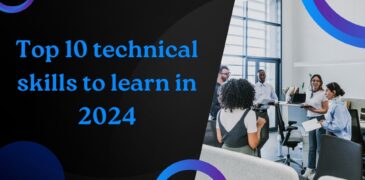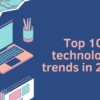In 2024, staying ahead in the tech world involves learning key technical skills that empower individuals in various fields. From coding languages like Python and JavaScript for software development, to mastering cloud computing and data analysis tools, these skills provide a foundation for success. As technology continues to advance, staying updated with emerging skills like machine learning, artificial intelligence, and cybersecurity ensures relevance and opens doors to exciting opportunities in the ever-evolving digital landscape. Embracing these skills equips individuals to navigate the future job market and contribute meaningfully to the tech-driven world.
Top technical skills to learn in 2024
Cloud computing
Cloud computing is a revolutionary technology that transforms the way businesses and individuals access, store, and manage data and applications over the internet. Key features include on-demand access to computing resources, scalability, and the outsourcing of infrastructure management to cloud service providers. With the ability to access computing power, storage, and software remotely, users can enjoy flexibility and cost-efficiency.
The benefits of cloud computing are vast. Enhanced agility and scalability empower businesses to adapt quickly to changing demands, adjusting resources as needed. Cost savings are significant, with users only paying for the resources they consume, eliminating the need for extensive on-premises infrastructure investments. Collaboration and accessibility improve as data and applications are accessible from anywhere with an internet connection, fostering seamless teamwork and remote work capabilities.
Data analysis
Data analysis is a critical process that involves inspecting, cleaning, transforming, and modeling data to extract valuable insights, make informed decisions, and uncover patterns or trends. Key features of data analysis include statistical analysis, machine learning algorithms, and visualization tools. These features enable users to derive meaningful conclusions from large and complex datasets, enhancing the understanding of various phenomena.
Data analysis aids in problem-solving by uncovering patterns and correlations within datasets. Predictive analytics, a subset of data analysis, enables forecasting future trends, optimizing resource allocation, and mitigating risks. Moreover, data analysis contributes to operational efficiency by identifying inefficiencies and streamlining processes. In healthcare, it supports diagnostics and personalized treatment plans, while in finance, it aids in risk management and fraud detection.
Artificial intelligence
Artificial Intelligence (AI) is a transformative technology that mimics human intelligence, enabling machines to perform tasks, learn from experiences, and adapt to changing environments. Key features of AI include machine learning, natural language processing, and problem-solving capabilities. Machine learning empowers systems to improve performance over time by learning from data, while natural language processing facilitates human-machine interaction. AI’s problem-solving capabilities involve tasks like pattern recognition, decision-making, and automation, making it versatile across applications.
The benefits of AI are far-reaching. Enhanced efficiency is a cornerstone, as AI automates routine tasks, reducing manual efforts and boosting productivity. Improved decision-making is another critical advantage, as AI processes vast datasets to provide insights and support strategic choices.
Programming
Programming is the process of designing and building sets of instructions that computers can execute. Key features of programming include coding languages, algorithms, and problem-solving methodologies. Coding languages, such as Python, Java, and C++, provide the means to communicate with computers, while algorithms enable the logical flow of instructions, and problem-solving methodologies guide developers in creating efficient solutions.
The benefits of programming are vast. Automation is a primary advantage, as programs enable the automation of repetitive tasks, reducing manual efforts and increasing efficiency. Improved problem-solving is another critical benefit, as programming encourages logical thinking and structured approaches to complex challenges.
Data science
Data Science is a multidisciplinary field that involves extracting insights and knowledge from structured and unstructured data through a combination of statistical, mathematical, and computational techniques. Key features of data science include data exploration, statistical modeling, machine learning, and data visualization. These features empower data scientists to uncover patterns, trends, and correlations within large datasets, providing valuable insights.
Data science contributes to innovation by leveraging advanced analytics to develop new products, services, and solutions. In healthcare, it aids in diagnostics and personalized medicine, while in finance, it enhances risk management and fraud detection.
Ethical hacking
Ethical hacking, also known as penetration testing or white-hat hacking, is a cybersecurity practice that involves authorized experts, often called ethical hackers or penetration testers, simulating cyberattacks on computer systems, networks, or applications to identify vulnerabilities and weaknesses. Key features of ethical hacking include the use of penetration testing tools, vulnerability assessments, and thorough analysis of security frameworks.
Ethical hacking enhances the overall security awareness of an organization by promoting a proactive cybersecurity culture. It fosters continuous improvement in security protocols, policies, and incident response mechanisms. The insights gained from ethical hacking engagements empower organizations to make informed decisions in securing their digital assets and maintaining the trust of their clients and stakeholders.
Digital marketing
Digital marketing is a dynamic and data-driven approach to promoting products or services using digital channels. Key features of digital marketing include a wide range of online platforms such as social media, search engines, email, and content marketing. It leverages analytics tools to measure campaign performance and target specific demographics with personalized content.
Digital marketing facilitates engagement and interaction with the audience through various channels, fostering brand loyalty and customer relationships. Real-time feedback and adaptability are additional advantages, enabling marketers to adjust strategies promptly based on the evolving digital landscape.
UX design
UX design include user research, wireframing, prototyping, and usability testing. User research involves understanding the needs and preferences of the target audience, while wireframing and prototyping create visual representations of the design for testing and refinement.
The benefits of UX design are pivotal in creating successful and user-centric experiences. Improved user satisfaction is a primary advantage, as a well-designed user interface enhances usability, making it intuitive and enjoyable for users to navigate. Enhanced accessibility ensures that the product is usable by individuals of diverse abilities and backgrounds.
Software development
Software development is the systematic process of conceiving, designing, coding, testing, and maintaining computer programs and applications. Key features of software development include programming languages, development frameworks, version control systems, and the application of software development methodologies such as Agile or Scrum. Collaboration tools and integrated development environments (IDEs) streamline the coding and debugging processes, ensuring efficient and organized development.
Quality assurance and reliability are critical benefits, as software development processes include rigorous testing methodologies to identify and rectify bugs or issues before deployment. Scalability allows software to adapt to changing requirements, ensuring it remains effective as businesses grow or evolve. Time and cost-effectiveness are also significant advantages, as modern development practices prioritize iterative and agile approaches, reducing time-to-market and development costs.
Cybersecurity
Cybersecurity is a critical field focused on safeguarding computer systems, networks, and data from unauthorized access, attacks, and damage. Key features of cybersecurity include robust encryption, firewalls, intrusion detection systems, and secure access controls. Encryption ensures the confidentiality of sensitive information, while firewalls act as barriers against unauthorized access. Intrusion detection systems monitor and respond to potential threats, enhancing overall system security.
Business continuity is another crucial benefit, as cybersecurity measures prevent disruptions caused by cyberattacks, ensuring the uninterrupted operation of critical systems. Safeguarding customer trust is paramount, as robust cybersecurity measures demonstrate a commitment to protecting user data and privacy, enhancing an organization’s reputation.
Web development
Web development is the process of creating and maintaining websites or web applications, involving a range of technologies and coding languages. Key features of web development include front-end and back-end development, client-server architecture, and the use of web frameworks and content management systems. Front-end development focuses on the user interface and experience, while back-end development handles server-side logic and database management.
Interactivity and user engagement are notable benefits, as well-designed websites encourage user interaction and seamless navigation. E-commerce capabilities empower businesses to conduct online transactions, expanding market reach and driving revenue. Accessibility ensures that websites are usable by individuals of diverse abilities, fostering inclusivity.
Conclusion
In conclusion, mastering key technical skills in 2024 is imperative for staying relevant in the ever-evolving digital landscape. Embracing programming languages like Python, staying adept in cloud computing, and acquiring expertise in data science are essential for harnessing the potential of emerging technologies. Additionally, cultivating proficiency in cybersecurity, artificial intelligence, and user experience (UX) design opens doors to innovation and problem-solving. The ability to adapt to the changing demands of technology ensures individuals are well-equipped to contribute meaningfully to a dynamic and competitive job market while fostering continuous personal and professional growth in the years ahead.
Read more:







